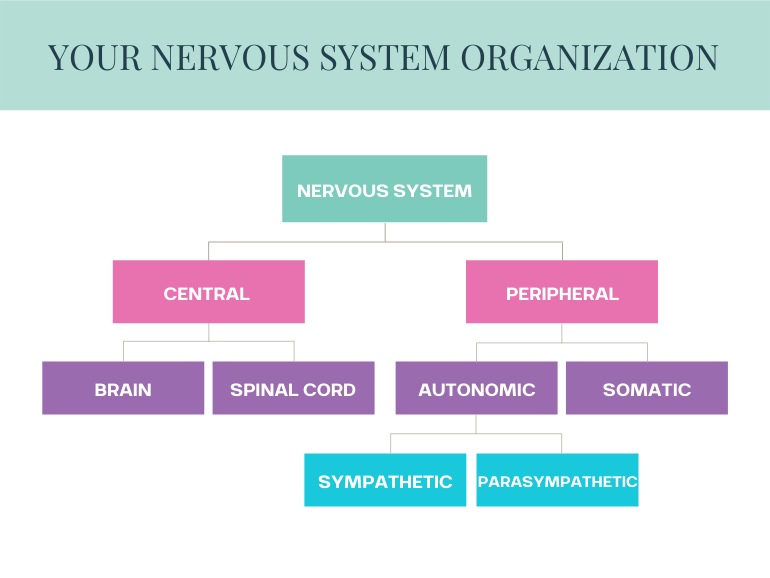How And Why Should You Nurture Your Nervous System?
What is the nervous system?
It is comprised of your brain and spinal cord, and it’s made up of literally billions of cells (like neurons). These cells connect and communicate… with more cells and nerves and chemicals (like hormones). They spread out through your ENTIRE body. Everything communicating throughout the rest of your body is called your peripheral nervous system.

Sending The Messages
Your nervous system is like a far-reaching, highly efficient messaging system. Messages are constantly being passed FROM: all areas of your body, all your organs, all your 5 senses (from everywhere!) TO: your brain. And your brain, as the amazing central-super-computer that it is, interprets and acts on this phenomenal amount of information.
It’s both miraculous and kind of crazy when you think about it.
Lots of the stuff happening in your nervous system is automatic (like your heart rate and your blood pressure… or like food moving through your intestines, or an egg releasing at ovulation). But some of it we can consciously control too, like walking or talking or dancing.
And some things in our bodies happen both automatically and/or when we control them. My favourite examples of this are breathing and pelvic floor contractions! Sometimes they happen automatically, and sometimes we tell our bodies to do them.
Organization of the Nervous System
The Sympathetic Branch
This branch directs the body’s quick and automatic response to what it perceives to be dangerous or stressful situations. It’s the part responsible for what we call our stress response, or the fight-or-flight (or freeze-or-fawn) response. (This is a bit of an oversimplification… the sympathetic nervous system has other jobs too – it is also active in non-emergency responses. However, it’s a great framework to start from.)
AND
The Parasympathetic Branch
The Parasympathetic branch: This branch is typically referred to as the “rest and digest”, recover and recharge system because it’s associated with energy conservation and processes like digestion and elimination of waste products from the body. (This is also an oversimplification, but a good start)

Thinking about the autonomic nervous system (and the sympathetic and parasympathetic systems) is REALLY important when it comes to the pelvic floor.
Unlike your knee or your ankle, your pelvis is home to some really important organs that are essential to your survival (cue the bladder and your bowels!). And optimal pelvic organ function needs optimal pelvic floor muscle function.
So the big take away here is that that organ function is under autonomic nervous system control and so is your pelvic floor. And that means:
Whatever is happening in your autonomic nervous system can be reflected in your pelvic floor too.
Example: Stress
If you are stressed, stress can show up as symptoms (often tension) in your pelvic floor.
Well guess what, most of us are stressed these days. In our western culture, we tend to lead pretty stressful lives. Here are some examples of what could be causing you stress right now:
- COVID and it’s far reaching effects on so many aspects of our lives
- Relationships (partners, extended family, friends, etc)
- Parenting
- Sleep deprivation (especially as parents!)
- Finances
- Environmental toxins
- Work
- School
- etc. etc. etc. the list is honestly endless
It’s no secret our lives are full of stress. As a result, we can see our sympathetic nervous system become up-regulated – the body and brain feel lots of stress, so the stress response ramps up.
But the up-regulation of our sympathetic nervous system takes its toll… on many areas of the body, but often on the pelvic floor too. We can see increased tension in our pelvic floor muscles. This can lead to increased urinary urgency and frequency. Or possibly bladder leakage. We can feel more pain – like pain in our pelvises (or SI joints, or pubic bones, or lower backs), and we can have pain with sex.
The best thing we can often do for our overall health is decrease our stress.
Decreasing stress is a worthy pursuit.
But some stresses aren’t going away any time soon.
Like COVID. Or like babies who often need months (or years!) to develop the ability to sleep for longer periods. So what can we do to help?
We can help our nervous systems find balance. We can try and stimulate and support the parasympathetic branch of our autonomic nervous system.
In our modern world, I truly believe we all need to spend time nourishing and nurturing our nervous systems.
Not sure how to do that? Let me help!
I’ve put together a great checklist of activities you can try that are scientifically proven to help your nervous system find balance.
Sign up below and download it today!
Start experimenting! What on that list sounds like it would feel good to you? What on the list haven’t you tried yet?
A nervous system nourishing practice can start with as little as 2-3 minutes a day. Your health deserves your time and a healthy, happy nervous system as at the root of good health.
~Mandy

